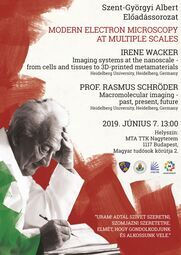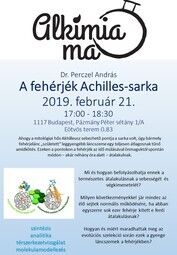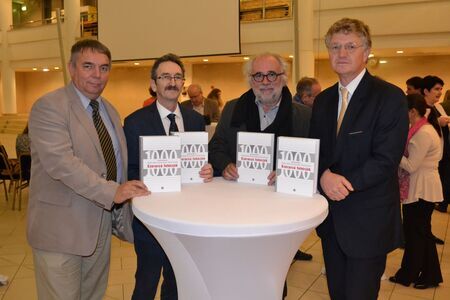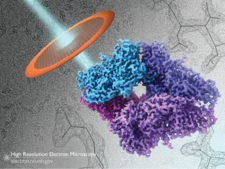News
Szent-Györgyi Lecture: Modern electron microscopy at multiple scales 2019-05-15
Modern electron microscopy at multiple scales (abstract, picture)
Irene Wacker: Imaging systems at the nanoscale - from cells and tissues to 3D-printed metamaterials
Prof. Rasmus Schröder: Macromolecular imaging - past, present, future
June 7. 2019, 1 p.m., MTA TTK

and Krio-EM mini conference:
László Buday: Complex formation of Tks4 scaffold protein with its binding partners
Scaffold proteins modulate signalling in cells via bringing regulatory proteins or enzymes in close proximity. Based on the structure of Tks4 scaffold protein, it seems to be capable of binding several protein partners. In the project, we wish to determine the 3D structure of Tks4 in complex with its binding partners.
András Szöllősi: Structure of TRPM2 cation channel from Nematostella vectensis
Transient Receptor Potential Melastatin 2 (TRPM2) is a non-selective cation channel important for the immune response, insulin secretion, and body temperature control. TRPM2 is activated by cytosolic Ca2+, phosphatidyl-inositol-4,5-bisphosphate and ADP ribose. Here, we present the ~3 Å resolution electron cryo-microscopic structure of TRPM2 from Nematostella vectensis, 63% similar in sequence to human TRPM2, in the Ca2+-bound closed state.
Bianka Farkas : Using cryo-EM maps to determine protein transmembrane regions
In order to understand transmembrane protein function and to develop novel therapies targeting diseases associated with these proteins, it is crucial to define the localization of transmembrane regions. Experimental data on the boundaries of membrane embedded regions is sparse, but now this information is present in cryo-electron microscopy (cryo-EM) density maps. Therefore, we developed a computational pipeline, which provides the first, atomic resolution experimental data set on transmembrane regions extracted from cryo-EM maps.
Zoltán Gáspári: Interaction networks of postsynaptic proteins
The postsynaptic density (PSD) is a dense protein network capable of dynamic reorganization, playing a key role in the molecular processes of learning and memory. Our aim is to decipher the partners and the interdependence between various interactions of selected PSD proteins by investigating the structure and dynamics of some key proteins and their complexes. We currently primarily use NMR spectroscopy but, depending on the properties of the proteins and complexes, we plan to apply other methods where appropriate.
Zoltán Urbányi: Structural characteritaion of the active pharmaceutical ingredients of biopharmaceuticals
In the case of both novel and biosimilar biopharmaceutical the detailed structural characterization is a regulatory requirement. This characterization can be performed by using an arsenal of different orthogonal methods as X-ray diffraction, NMR, FT-IR, CD, HDX-MS etc. All of these methods have limitation to determine the exact structure of proteins in solvent phase. Cryo-EM may provide a kind of solutions for the problem of correct structural determination and comparison.
András Málnási-Csizmadia: Drug development targeting myosin
Cryo-EM Workshop 2018-12-18
MEDInPROT and JEOL Workshop on Cryo-Electron Microscopy
10th of January 2019. Thursday
ELTE TTK 1117 Budapest, Pázmány Péter sétány 1/a, 1.71 Pócza Jenő room
10:30 Welcome by Prof. András Perczel
10:35 Short introduction of electron microscopy by Guillaume Lathus
10:45 Cryo-EM in Biology by Emanuel Katzmann PhD
Cryo-electron microscopy (cryo-EM) has taken enormous flight in recent years and has gained an enormous momentum resulting in the award for the Nobel Prize in Chemistry. Atomic level structural analysis of viruses and proteins derived by cryo-EM requires high stability hardware and software. JEOL proudly announces its latest offering in cryo-TEMs to facilitate this development in cryo-EM.
11:40 Cryo-EM in Material Science by Guillaume Brunetti PhD
The development and subsequent application of new materials depends on a fundamental understanding of their structure and properties, and the bonding between atoms. Microstructural information and surface/bulk chemical analyses are readily obtained from these instruments with absolutely state-of-the-art results.
12:40 Coffee break
13:00 Tomography by Sylvain Trépout, PhD
Introduction of Electron Tomography: a combination of cryogenic techniques for specimen preparation, electron microscopy for data collection, and tomographic reconstruction techniques for visualization in three dimensions.
14:00 Cryo-EM in practice by Guillaume Brunetti and Emanuel Katzmann
Cryo-EM in practice, tips and hints for users
14:40 Quiz
15:00 Lunch
For registration please send an email to medinprot@chem.elte.hu with the subject ‘Cryo-EM 10th of January 2019.’ until the 28th of December.
Merry Christmas and Happy New Year! 2018-12-12

Book Launch: Ezerarcú fehérjék 2018-11-16
László Buday, László Nyitray, László Táncos and András Perczel
10. Conference of MedInProt - presented at the conference 2018-11-16
The tenth Conference of the MedInProt Protein Science Research Synergy Program was held on November 10. 2018, at Eötvös Loránd University.
Gábor Pál: Irányított fehérjeevolúció alapkutatástól gyógyszerfejlesztésig
László Poppe: Francis Arnold: Revolution based on evolution
József Tímár: The enemy of my enemy is my friend: Medical Nobel prize 2018: Basics of immunoncology
The role of the scaffold protein Tks4 in cancer cell motility – László Buday, András Czirók
Setup of inflammation induced permeability measurements by gold nanoparticles and optical biosensor – László Cervenak , István László Lagzi, Róbert Horváth
Podocin: the pivotal relationship of the transmission rate and the oligomerization of a membrane protein – Dóra K.Menyhárd, Gusztáv Schay, Kálmán Tory
Mastering Cell Counting: about the Countess FL instrument – Szilvia Bősze, Tamás Beke-Somfai
Inhibition of pathophysiological interactions of S100 proteins with foldamers - László Nyitray, Tamás Martinek
Péter Gál: Proteases in the immune system: The complement system
Attila Reményi: Protein kinas
András Szarka: The investigation of the key proteins in high dose ascorbate and acetaminophen induced cell death
Tibor Vellai: The regulation and mechanism of the aging process
Beáta Vértessy: Capturing the elusive uracil-DNA pattern
10. Conference of MedInProt - visiting lecturers 2018-10-29
Pál Gábor: Irányított fehérjeevolúció alapkutatástól gyógyszerfejlesztésig
László Poppe: Francis Arnold: Revolution based on evolution
József Tímár: The enemy of my enemy is my friend: Medical Nobel prize 2018: Basics of immunoncology
It was a long presistent idea among immunologists that stimulation of the immune system could be the way to achieve antitumoral immune responses. However, these techniques failed to be clinically active. Tumor immunology in the meantime disregarded the fact that negative regulation of the T-cell receptor signaling is equally important compared to stimulatory regulations in T-cell mediated immune responses. Recently than it was discovered that cancers are actively blocking the mounting antitumoral immune responses by activating the so-called check-point inhibitory mechanisms such as CTLA-4 and PD/PDL1.
The role of the scaffold protein Tks4 in cancer cell motility – László Buday, András Czirók
The scaffold protein Tks4 is a participant both in EGFR singalling and podosome formation. Our joint experiments showed, that the functional deletion of Tks4 (Tks4 KO) alters the motility of human colorectal carcinome cells. The Tks4 KO cells are able to make longer journeys and do them faster, than their wild type counterparts.
Setup of inflammation induced permeability measurements by gold nanoparticles and optical biosensor – László Cervenak , István László Lagzi, Róbert Horváth
We investigated and monitored the penetration of charged nanoparticles into adhered HeLa cells by using Epic BT optical biosensor in a real-time and completely label-free manner. Our results show that the cellular uptake of positively charged nanoparticles (AuTMA) is more effective compared to the negatively charged nanoparticles (citrate capped nanoparticles). This finding supports our hypothesis that the cell membrane and nanoparticle interaction plays a crucial role in the penetration of the charged particles since the membrane composition of the cells are negatively charged, thus attractive electrostatic interaction can help nanoparticles to be internalized into the cells.
Podocin: the pivotal relationship of the transmission rate and the oligomerization of a membrane protein – Dóra K.Menyhárd, Gusztáv Schay, Kálmán Tory
Podocin is the first protein with an oligomerization-dependent variant (R229Q), which is only pathogenic in specific heterooligomers. During the last years, we revealed several aspects of the underlying pathomechanism: the oligomerization sites, the effect of R229Q on the oligomerization and its relationship with the membrane-targeting. Such a mutation-dependent pathogenicity of a variant is a challenging aspect in the clinical practice: to help its assessment we recently set up population-genetic, biochemical and clinical criteria.
Mastering Cell Counting: about the Countess FL instrument – Szilvia Bősze, Tamás Beke-Somfai
The Countess™ II FL Automated Cell Counter is a benchtop assay platform equipped with state-of-the-art optics for rapid assessment of cells in suspension. With three-channel flexibility — brightfield and two optional fluorescence channels— cell viability, cell size distribution can be measured. The cytotoxicity, apoptotic or proliferative effect of different antimicrobial and antitumor peptides, foldamers and their derivatives can be determined in a high-throughput manner exhibiting plate-based assay quality.
Inhibition of pathophysiological interactions of S100 proteins with foldamers - László Nyitray, Tamás Martinek
The aim of the cooperation is to find high affinity foldameric ligands of S100 proteins to disrupt their pathophysiological protein-protein interactions.
First, to find low micromolar binding partners, the surfaces of 8 members of the S100 protein family were mapped with a 256-membered foldamer helix library using a pulldown-assay, then fluorescence polarization was measured to quantify the interactions between selected foldameric fragments and different S100 proteins.
In case of S100A4 and S100B, which are particularly important in therapeutic point of view, competitive pulldown assays were performed to confirm that the recognition site of the foldameric fragments is the same as the native ligands.
Péter Gál: Proteases in the immune system: The complement system
New tricks for an ancient system
The complement system, consisting of exclusively protein molecules, is a powerful effector component of the innate immune system. The system has about 40 protein components and contributes to the development of the immune response in various ways. In the recent years we have discovered novel functions of the complement system ranging from the direct cell activation to the facilitation of the blood coagulation.
Attila Reményi: Protein kinas
Protein kinases rarely act solo, as they are part of hierarchically organized cascades or more intertwined kinase networks. Surprisingly we know little about how kinases get turned on by other kinases because we lack structural information on how kinase heterodimers assemble. In my talk I will present how different MAP kinases specifically turn on other kinases involved in cell growth or death.
András Szarka: The investigation of the key proteins in high dose ascorbate and acetaminophen induced cell death
High dose ascorbate and acetaminophen induced cell death and ferroptosis share common features such as production of reactive oxygen species, lipid peroxidation, caspase independency and the possible involvement of autophagy. These observations lead us to hypothesize that ferroptosis may also be involved in cancer cell death due to pharmacologic ascorbate treatment and in liver cell death due to acetaminophen overdose. Thus cell death of HT-1080 or cell line primary mice hepatocytes was induced by ferroptosis inducers and pharmacologic ascorbate or by acetaminophen overdose then the mechanism of cell death was compared.
Tibor Vellai: The regulation and mechanism of the aging process
Despite its medical, social and economic significance, understanding the mechanism of the aging process remains a fascinating and fundamental problem in biology According to our results, aging may be driven by genomic instability caused by the lifelong, progressive mobilization of mobile genetic elements (MGEs, also called “jumping genes”), which constitute major parts of eukaryotic genomes. Piwi proteins effectively repress MGEs in non-aging cells such as germline and cancer stem cells, while these proteins remain unexpressed in aging somatic cells. The regulation of the aging process is mainly achieved by EDTP/MTMR14 myotubularin-like lipid phosphatases that increasingly block autophagy in several cell types during adult lifespan.
Beáta Vértessy: Capturing the elusive uracil-DNA pattern
The true chemical space of DNA is much wider than previously thought, however, it is still a considerable task to decipher the real chemical composition and sequence of the genomic material. Using a novel approach, we have developed a protein sensor to capture uracil moieties in DNA for both Chip-sequencing and in situ super-resolution microscopy. The pattern of uracil distribution show intriguing characteristics and may shed light to the distribution of repair tasks among different DNA repair pathways.
Book Launch: Ezerarcú fehérjék
10. Conference of MedinProt 2018-10-29
We cordially invite you to the 10th MedInProt Conference held at ELTE TTK Eötvös lecture hall on Saturday, November 10, 2018 starting at 9 AM.
All interested are invited and welcome!
8. Conference of MedInProt - presented at the conference 2018-04-23
The eighth Conference of the MedInProt Protein Science Research Synergy Program was held on April 21. 2018, at Eötvös Loránd University.
László Nyitray: Resolution revolution
Max Maletta: How Cryo-EM is changing the Structural Biology landscape for the best
Ágnes Hubert: From protein sample to high-resolution cryo-electron microscopy map
Gergő Gógl: A crystallographer’s perspective on cryo-electron microscopy
Mihály Pósfai: New scientific directions in electron microscopy laboratory
The role of ion channels and pumps in tumor metastasis
Interaction of lysophosphatidic acid with signalling protein domains: affinity, stoichiometry and the site of binding
Role of the scaffold protein Tks4 in cancer cell movement
Setup of inflammation induced permeability measurements by gold nanoparticles and optical biosensor
Pathogenicity and oligomerization of podocin
Nanomechanical tests in the diagnostics of genodermatoses
Studying decision making process between cell death mechanisms: the GSH switch - ferroptosis and autophagy in focus
Investigation of the role of dynamin mediated and mitochondrial pathways in the background of centronuclear myopathy
8. Conference of MedInProt - visiting lecturers 2018-03-29
Mihály Pósfai: New scientific directions in electron microscopy laboratory
Ferenc Vonderviszt: The revolution of cryo-electron microscopy in determination of biomolecular structures
Recent advances in cryo-electronmicroscopy have dramatically reshaped the landscape of structural biology. This technique can be used to determine the three-dimensional structure of biomacromolecules in near native conditions at close to atomic resolution, and has the potential to reveal multiple conformational states related to the dynamic behavior of molecular complexes. Cryo-EM now produces very excit¬ing results addressing a broad range of important biological questions with a level of detail we have never seen before.
Ágnes Hubert: From protein sample to high-resolution cryo-electron microscopy mapCryo-electron microscopy (cryo-EM), is an increasingly popular technique allowing the examination of a frozen-hydrated specimen in vitreous (non-crystalline) ice. The technique complements X-ray crystallography by revealing structural details without the need for a crystalline specimen. The workflow of single-particle cryo-EM is demonstrated with the case-study of three archaeal protein complexes and the structure of the eukaryotic 26S proteasome.
Gergő Gógl: A crystallographer’s perspective on cryo-electron microscopyI will discuss the advantages and the potential problems of cryo EM modelling in constrast to the conventional crystallographic structure determination.
László Nyitray: Resolution revolution
The Nobel prize in chemistry in 2017 was awarded to Jacques Dubochet, Joachim Frank and Richard Henderson for developing cryo-electron microscopy as a structural biology method. In the lecture the development of the Method of the Year in 2015 will be briefly described together with the contribution of the Nobel prize winners and further methodological progress in the last couple of years that explains the "resolution revolution".
Max Maletta: How Cryo-EM is changing the Structural Biology landscape for the best
In 2017 R. Henderson, J. Frank and J. Dubochet have been awarded the Nobel prize in Chemistry for having pioneered cryo electron microscopy (Cryo-EM) and Single Particle Analysis (SPA).
During the last few years Cryo-EM and SPA have grown from techniques able to produce low-resolution structures of protein complexes to tools capable of achieving atomic and quasi-atomic resolution for complexes that nobody could solve with any other technique.
This incredible leap forward has been made possible through the introduction and adoption of new tools, in particular direct electron detectors (DED), ultra-stable cryo-microscopes, such as the Titan Krios and the adoption of new SW for automatic data collection and processing.
Cryo-EM benefits of specific advantages, with respect to other structural biology techniques such as NMR and X-ray diffraction:
. Crystallization or isotopic labelling is not needed.
. The amount of sample required is two orders of magnitude lower.
. Different functional conformation of a protein complex may be revealed.
Cryo-EM has proven to be a very useful technique to be integrated with X-ray and NMR for structure-based drug design Thus it is no surprise that many structural biology groups all over the world are seeking access to this technology in order to find answers to their most relevant biological questions. Nevertheless most users that are new to the field of cryo-EM are struggling to overcome the adoption barrier that this technique may pose in terms of: sample preparation and screening, automatic data acquisition and progressive users training.
In this presentation we will present how the fast pace of cryo-EM growth is going to revolutionize the structural biology landscape. In addition, the latest Thermo Fisher Scientific technologies/solutions will be introduced:
- The cryo-EM SPA workflow with the recently introduced electron microscopes Krios G3i and Glacios - today the most economical and efficient Cryo-EM solutions for getting to the 3D structure of protein molecules.
- The recent advances in electron cryo-tomography with the cryo focused-ion-beam, an application for visualization of biological structures in their native, cellular context at the molecular-scale.
- The new development of mED (Micro electron Diffraction): a technology that holds the promise to solve the high resolution 3D structure of proteins crystallized into very small., an interesting cost effective alternative for XFEL.
8. Conference of MedInProt 2018-03-26
We cordially invite you to the 7th MedInProt Conference held at ELTE TTK Eötvös lecture hall on Saturday, April 21, 2018 starting at 9 AM.
Winners of the Synergy VI., VII. and the Feasibility Study Program shall present their joint research at the conference. In addition, topic covers in cryo-EM Mihály Pósfai and Ferenc Vonderviszt will give lectures.
The conference will end with sweepstakes and poster discussions.
All interested are invited and welcome!
MedInProt film 2018-01-31
Merry Christmas and Happy New Year! 2017-12-14

Bruckner termi előadás - Kajtár-Hollósi emlékülés 2017-11-16
MEGHÍVÓ
Az MTA Szerves és Biomolekuláris Kémiai Bizottság és a Kajtár-Hollósi Alapítvány tisztelettel meghívja Önt, barátait, tanítványait és minden kedves érdeklődőt a soron következő „Bruckner termi előadásra” és az Alapítvány emlékülésére
Időpont: 2017. december 1. péntek 14.00 óra
Helyszín: ELTE TTK Kémiai Épület, (1117 Budapest, Pázmány P. sétány 1/a)
063-as „Bruckner-terem”
Molecular Frontiers Symposium - 7. Conference of MedInProt 2017-09-21
The Molecular Frontiers Symposium was held on September 14-15. 2017, at Eötvös Loránd University.
Molecular Frontiers / MedInProt - ELTE
Presented at the conference:
Kurt Wüthrich: Protein Dynamics Seen by NMR
Arieh Warshel: Simulating the Action of Complex Biological Systems
Bill DeGrado: De Novo Protein Design
Harry Gray: Living with Oxygen
Pernilla Wittung-Stafshede: Protein folding is basis of life and death
Tim Hunt: Switches and Latches and the Control of Mitosis
Reiko Kuroda: Protein functions and point mutations of the genes
Éva Kondorosi: The miracles of symbiosis
Wayne A. Hendrickson: Structural Basis of Activity of RyR1 Calcium Release Channels
Chris Dobson: The Amyloid State of Proteins and its Significance in Biology and Medicine
Molecular Frontiers Symposium - 7. Conference of MedInProt 2017-06-07
September 14-15. 2017, at Eötvös Loránd University
Molecular Frontiers (www.molecularfrontiers.org) is an international network formed by researchers and professors. This organization focuses on highlighting the importance of molecular sciences in a wide range of society, thus attracting young people towards science. Molecular Frontiers Symposia, organized for the upper purpose gathers leading scientists of the Globe, usually to discuss the topic of a current global problem. The actual issue and the attendees of these events are decided by the Scientific Committee (many members of which are Nobel laureate scientists); thus young student (age usually from 14 to 25) and other participants have the opportunity to meet the top researchers of the field. Further information regarding past events at: http://www.molecularfrontiers.org/symposia).
On each symposia 10 to 12 researcher hold lectures many of whom have received a Nobel Prize. On the demonstrating photo a group picture of the 2015 event in Göteborg can be seen. More than 1000 students and researchers attend Molecular Frontiers events, moreover, thanks to the recently initiated live broadcasting via internet, Molecular Frontiers Symposia are becoming rapidly expanding international events.
We believe that the Hungarian organization of such a prestigious event not only furthers molecular science’s popularity and recognition among the young, but also promotes the international (mostly inter EU) recognition of Hungarian research, thus, fulfilling an important national interest. The currently chosen topic shall follow the theme of an actual Hungarian program known as MedInProt initiative, with the purpose of assisting the communication among scientists working in the fields of protein sciences and pharmacology. The goal of MedInProt and Molecular Frontiers is to efficiently support the more successful integration of Hungarian scientists into the international network.
Registration: https://www.mke.org.hu/MolecularFrontiers2017/en/
Tavaszi lendület a MedInProtnál 2017-05-02
Friss ötletek - gyors támogatás: jelentkezzen még ma!
(Az Ön ötlete és kezdeményezése nekünk is fontos! )
Vesse föl új és eredeti ötletét, akár még ma, nyújtsa be támogatási igényét, és a MedInProt kuratóriuma rövid megfontolás után, ha a kezdeményezést méltónak találja, azonnal támogatja is. „first come first served”.
Figyelmébe ajánlom „Megvalósíthatósági” programunkat (http://medinprot.chem.elte.hu/hu/palyazatok/uj-palyazatok)
Támogathatósági feltételek:
- a szinergiában résztvevő kutatók közül legalább az egyik a 4 központi intézmény (ELTE, BME, MTA-TTK, SE) valamelyikében legyen főállású közalkalmazott,
- a javaslat világosan mutasson rá arra, hogy Ön és társa(i) az ad hoc támogatásnak köszönhetően hogyan jutnak közelebb hosszú távú a közös munkához és egy közös pályázáshoz akár hazai, akár nemzetközi fórumon.
Jelen „ad hoc” támogatás volumene:
200 eFt <= x <= 2M Ft (eltérés csak kiemelten indokolt esetben lehetséges)
Jelen „ad hoc” támogatás pályázási határideje:
2017. május 10.
Beadás módja:
Küldje el a
medinprot@chem.elte.hu
e-mail címre.
Budapest, 2017. május 2.
Perczel András
a MEDinPROT kuratórium elnöke




